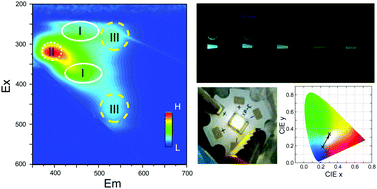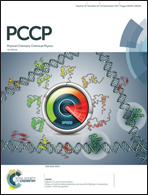Insight into the multiple quasi-molecular states in ethylenediamine reduced graphene nanodots†
Abstract
Recently, graphene nanodots (GNDs) have been frequently considered as inherently heterogeneous systems, leading to multicolor emission under a changeable excitation wavelength. However, an accurate picture of the GNDs and an exhaustive structure–property correlation are still lacking. Using a two dimensional photoluminescence excitation (2D-PLE) map, molecular orbital calculation, reduction level dependent PL analysis, absorption spectroscopy and time-resolved PL spectroscopy, three cases of quasi-molecular PL are determined in ethylenediamine (EDA) reduced GNDs, including the C![[double bond, length as m-dash]](https://www.rsc.org/images/entities/char_e001.gif) O related electronic state, graphenol related electronic state and large π-conjugated domains. The graphenol structure is expected to be created via nucleophilic addition–elimination reactions between epoxide groups and EDA, contributing most to the blue-shifted and enhanced PL of GNDs. The multiple quasi-molecular PL provides deeper insights into the commonly called “excitation wavelength dependent PL”. An effort is made to utilize the heterogeneous photoluminescence through phosphor-based light-emitting diodes employing reduced GNDs as a phosphor, which are capable of converting blue light into white light.
O related electronic state, graphenol related electronic state and large π-conjugated domains. The graphenol structure is expected to be created via nucleophilic addition–elimination reactions between epoxide groups and EDA, contributing most to the blue-shifted and enhanced PL of GNDs. The multiple quasi-molecular PL provides deeper insights into the commonly called “excitation wavelength dependent PL”. An effort is made to utilize the heterogeneous photoluminescence through phosphor-based light-emitting diodes employing reduced GNDs as a phosphor, which are capable of converting blue light into white light.



 Please wait while we load your content...
Please wait while we load your content...